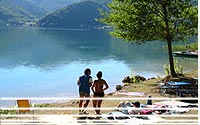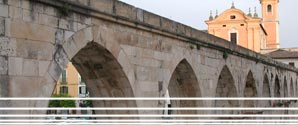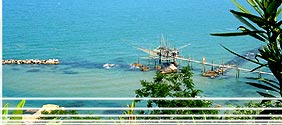 |
|
 |
Sulmona:
Easter Rapresentation
| |
-Introduction
Easter performances in Sulmona have ancient roots,
and it is thought they are Christianity fitted
versions of ancien heathen rites performed in
early Spring in order to wish good harvests and
an enduring freedom.
The processions are organized by two different
Confraternities:
The Holy Trinity, which organizes the Procession
of the Dead Christ on Good Friday evening, and
the Confraternity of the St. Lady of Loreto (or
"of the Grave"), ehich is responsible
for the "Madonna che Scappa in Piazza"
(The Madonna running in the square) on Easter
Sunday morning.
Rivalries between the two Confraternities have
always been heated so that each one organized
its performance within the limits of their parish
territory. The current organization provides a
kind of sharing between the Confraternities. |
|
 |
| |
The
Good Friday Procession
The procession, also known ad the procession
of the Dead Christ, sees the participation
of hundreds of brethren wearing the traditional
red habit, symbol of the charity flame,
adorned with a white wimple ( a cloth standing
from the neck to the breast) of Spanish
origins and with a badge more or less wide
according to the importance of the person
wearing it.
The procession leaves the Holy Trinity Church
at seven o' clock (there is actually a traditional
and pleased delay) preceded by a brass band
playing famous dead marches. The long line
covers the main city roads with a well defined
disposition, which sees at the beginning
a square of lamps surrounding the "Trunk",
a Cross covered with red velvet and silver
ornaments. Then a group of paired lamps
at the borders of the street, closed by
a small group od children with the Passion
symbols.
After them there is the choir, composed
by 120 choristers divided into tenors, barytones
and basses, singing different kinds of Miserere;
it's one of the most spectacular parts of
the procession and thus the most aimed.
Soon after, the Priest precedes the Christ's
Coffin, followed by the Statue of the Virgin,
dressed in a black cloth which will be left
only at the moment of the Sunday "run"
in the square. The procession is closed
by the gonfalon and the civil, militar and
religious authority representations, and
by a lot of believers.
Late in the evening the procession comes
back to the Holy Trinity Church after a
pause on the parvis of the Church of the
Grave and the crossing of the very crowded
main street. |
|
 |
|
 |
|
(Madonna che Scappa in
Piazza)
Sulmona, 400 mt |
 |
|
"The Madonna running in Square"
The representation of Sunday Easter takes
place at Midday in full of people Piazza
Garibaldi. At 11:30 the two statues of St.
Peter and St. John the Evangelist enter
the Square, the two Apostles who, according
to the Gospel, were the firts to became
aware of the Resurrection. The Statues move
toward St. Philip Church: under the three
arches we can see the Statue of the Resurrected
Christ, which is set on a red baldachin.
All around there are many lamps-bearer of
the Confraternity of St. Lady of Loreto,
dressed in a white surplice and cordon with
a green cape , symbol of hope and of the
new season, and wearing the traditional
plaque.
Meanwhile, the two Saints knock on the Church
main door to announce the Virgin the Resurrection,
and She, still dressed in black clothes,
comes out incredulous after three announcements.
Out of the door She moves toward the place
marked by the Apostels who follow Her. Opposite
the Fountain, the Madonna sees Christ, She
leaves her black clothes, unveiling a shining
green dress and a joyful pigeon flying,
and runs toward Her Son.
At the end of the run there is a great many
crackers let off, the band playing, a burts
of applause and the moved embrace of the
nrethren to the four runners who are elected
from year to year. From the good performance,
the right falling of the black cloth and
from the pigeon flying, the citizens of
Sulmona derive wishes for the new season
and the next future of the city. It is the
most moving moment of the entire Easter
period and the citizens live it between
hope and tension. The ceremony ends with
the procession, after the confusion following
the arrival of the Madonna, coming back
to the Church of St. Lady of Loreto, after
covering the main street.
English version by Marco
Paolini
|
|
|
|
|
 |
 |
| Beach
hotels |
| the most beautiful beaches
of Italy in the best hotels |
|
|
|


